Edge detection refers to the process of identifying and locating sharp discontinuities in an image. Hence, edge detection is a vital step in image analysis and it is the key of solving many complex problems. Edge detection is a fundamental tool used in most image processing applications to obtain information from the frames as a precursor step to feature extraction and object segmentation. The edge detection has been used by object recognition, target tracking, segmentation, data compression, and also helpful for matching, such as image reconstruction and so on. Edge detection methods transform original images into edge images benefits from the changes of grey tones in the image. In this research paper, two edge detection algorithms namely Canny edge detection and Sobel edge detection algorithm are used to extract edges from facial images which is used to detect face. Performance factors are analyzed namely accuracy and speed are used to find out which algorithm works better. . From the experimental results, it is observed that the Canny edge detection algorithm works better than Sobel edge detection algorithms.
Keywords |
| Image mining, Face detection, Edge detection, Canny, Sobel. |
INTRODUCTION |
| Face recognition is defined as the process of automatically identifying and verifying a person from a digital image.
Face recognition is one such important application in which edge detection plays a key role. Computer based face
recognition systems for security applications is a widely researched topic as facial features provide unique biometric
identity for users. Face recognition systems are based on object recognition and tracking technologies. One of the
important steps in object recognition is successful edge identification and extraction. |
| Edge detection is an important image processing technique with wide range of applications. Several edge detection
algorithms have been developed in the past few decades, however no single algorithm is suitable for all types of
applications. One of the main applications of edge detection techniques is in the process of image segmentation and
object detection. Edge maps help in representing faces as a single unit. An edge detection system has wide variety of
applications, as shown in figure 1. |
| 1. Filtering: Some major classical edge detectors work fine with high quality images, but often are not good enough for
noisy pictures because they cannot distinguish edges of different significance. Noise is unpredictable contamination on
the original image. There are various types of noise, but the most broadly studied two kinds are white noise and ―salt
and pepper‖ noise. During salt and pepper noise, pixels in the image are very different in color or intensity from their
surrounding pixels; the defining characteristic is that the value of a noisy pixel bears no relation to the color of
surrounding pixels. In general this type of noise will only affect a small number of image pixels. When analysed, the
image contains dark and white dots, hence the word salt and pepper noise. |
| 2. Enhancement: Digital image enhancement techniques are concerned with improving the quality of the digital image.
The principal objective of enhancement techniques is to produce an image which is better and more suitable than the original image for a specific application. Linear filters have been used to solve many image enhancement problems.
Not all image sharpening problems can be satisfactorily addressed through the use of linear filters. |
| 3. Detection: Many points in an image have a nonzero value for the gradient, and all of these points are not considered
as edges for a particular application. Some methods should be used to determine which points are edge points or not. |
REVIEW OF LITERATURE |
| Zolqernine Othman et al., [1] author discussed, that Canny method can produce equally good edge with the
smooth continuous pixels and thin edge. Sobel edge detection method cannot produce smooth and thin edge compared
to canny method. But same like other method, Sobel and Canny methods also very sensitive to the noise pixels.
Sometime all the noisy image cannot be filtered perfectly. Unremoved noisy pixels will affect the result of edge
detection. From the analysis, it was shown that between Sobel and Canny edge detection algorithms, response given by
Canny edge detection was better than result of Sobel detector used in these MRI images. |
| M Sudarshan et al., [5] author proposed an optimized edge detection algorithm suitable for the face recognition
task. The main idea of the proposed method is to boost the significant edges and then apply successive thinning
algorithms. The two advantages of this method over other gradient based systems is its ability to find missing and
broken edges more accurately and suppress the less significant edges. Possible future work is to enhance the thinning
algorithm such that it is able to suppress the noise in post processing stage more effectively. |
| Soumya Dutta et al., [9] author tested the proposed method on different images. It produced stable and fairly good
results. Consistent acceptable outputs over different kinds of real life images have proved robustness of the presented
scheme. Thus, the proposed method may be handy for any computer vision task where extraction of edge maps is
required for a large set of images for feature extraction or for any other work. The next venture will be comparing those
algorithms with the proposed one and analyze the performance on the basis of parameters like computing time,
execution complexity and accuracy of the system output in presence of noise. |
METHODOLOGY |
| Edge detection filters out ineffective data, noise and frequencies while preserving the important structural properties
in an image. Edge maps are one of the popular ways to represent facial images and its features. In this research paper
edge detection algorithms are compared to find out best among Sobel edge detection and Canny edge detection
algorithm. The methodology is as follows: |
| 1. Dataset- Facial images can be collected |
| 2. Edge detection |
| Canny |
| Sobel |
| 3. Best technique among edge detection algorithm |
| Canny |
| CANNY EDGE DETECTION |
| The Canny Edge Detector is one of the most commonly used image processing tools, detecting edges in a very
forceful manner. The Canny edge detector is widely considered to be the standard edge detection method in the
industry. Canny saw the edge detection problem as a signal processing optimization problem, so an objective function
is developed to be optimized. The solution to this problem was a rather difficult exponential function, but Canny found
numerous ways to approximate and optimize the edge-searching problem. The steps in the Canny edge detector are as
follows: |
| 1. Smooth the image with a two dimensional Gaussian. In large amount of cases the computation of a two dimensional
Gaussian is costly, so it is estimated by two one dimensional Gaussians, one in the x direction and the other in the y
direction. |
| 2. Take the gradient of the image. This demonstrates changes in intensity, which indicates the occurrence of edges. This
genuinely gives two consequences, the gradient in the x direction and the gradient in the y direction. |
| 3. Non-maximal suppression- Edges will occur at points the where the gradient is at a maximum. Hence, all points at a
maximum should not be suppressed. To facilitate this, the magnitude and direction of the gradient is computed at each
pixel. After that for each pixel check if the magnitude of the gradient is greater at one pixel's distance away in either the
positive or the negative direction perpendicular to the gradient. If the pixel is not larger than both, suppress it. |
| 4. Edge Thresholding- The method of thresholding used by the Canny Edge Detector is referred to as "hysteresis". It
makes utilize of both a high threshold and a low threshold. If a pixel has a value above the high threshold, it is set as an
edge pixel. If a pixel has a value above the low threshold and is the neighbour of an edge pixel, it is set as an edge pixel
as well. If a pixel has a value above the low threshold but is not the neighbor of an edge pixel, it is not set as an edge
pixel. If a pixel has a value below the low threshold, it is never set as an edge pixel. |
| The general algorithm for the Canny edge detector is as follows: |
 |
| SOBEL EDGE DETECTION |
| Sobel method is applied to perform edge detection. The Sobel edge detector use two masks with 3x3 sizes, one
estimating the gradient in the x-direction and the other estimating the gradient in the y-direction. The mask is slid over
the image, manipulating a square of pixels at a time. The algorithm calculates the gradient of the image intensity at
each point, and then gives the direction to increase the image intensity at each point from light to dark. Edges areas
represent strong intensity contrasts which are darker or brighter. |
| Sobel algorithms work using a mathematical procedure called convolution and commonly analyze derivatives or
second derivatives of the digital numbers over space. We implement the Sobel method for edges detection, which is
based on a 3 by 3 array that is moved over the main image. |
| The Sobel convolution kernels are designed to respond to edges vertically and horizontally. These masks are
each convolved with the image. It calculates horizontal and vertical gradient (Gx and Gy), then combined together to find the absolute magnitude of the gradient at each point and the orientation of that gradient. These numbers are used to
compute the edge magnitude which given by: |
 |
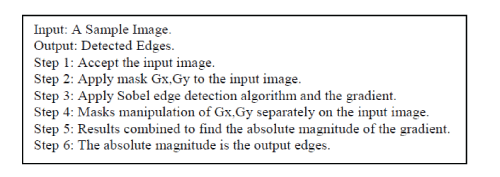 |
EXPERIMENTAL RESULTS |
| A. ACCURACY MEASURE |
| The following table shows the accuracy measure of various edge detection algorithms. A confusion matrix is a
specific table layout that allows visualization of the performance of an algorithm. Each column of the matrix represents
the instances in a predicted class, while each row represents the instances in an actual class. A table of confusion is a
table with two rows and two columns that reports the number of false positives, false negatives, true positives, and true
negatives. |
| From the analysis of Accuracy Measures of edge detection algorithms from the Table 1, Canny edge
detection algorithm outperforms well when compared to Sobel edge detection algorithm. |
| From the graph 1, it is observed that Canny edge detection algorithm attains high percentage of accuracy when
compared to Sobel edge detection algorithm. |
| From the analysis of Accuracy Measures of edge detection algorithms from the Table 2, Canny edge
detection algorithm detect in fewer seconds when compared to Sobel edge detection algorithm.From the graph 2, it is observed that Canny edge detection algorithm detects takes less execution speed when
compared to Sobel edge detection algorithm. |
CONCLUSION |
| Since edge detection is the early step in object recognition, it is significant to know the differences between edge
detection techniques. Representing an image by its edges has the advantage of reducing the amount of data required to
be stored while retaining most of the image information. Transmitting of the edge pixels in an image or multimedia
would result in a great deal of compression and there exists very reliable algorithms to reconstruct the entire image
based on the edge map. In this research paper the relative performance of various edge detection techniques is carried
out with a set of images. It have been observed that that the Canny edge detection algorithm produces higher accuracy
in detection of edges and execution time compared with Sobel edge detection algorithm. |
Tables at a glance |
 |
 |
| Table 1 |
Table 2 |
|
Figures at a glance |
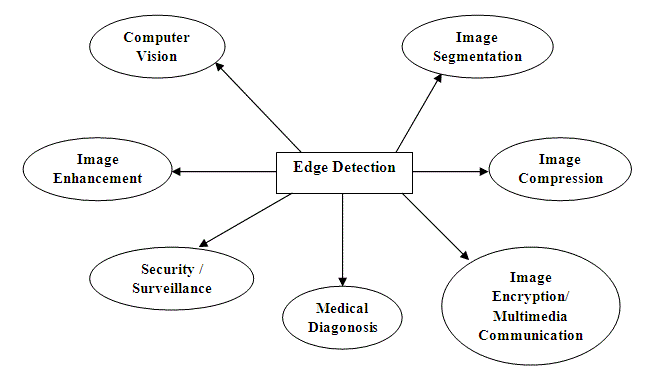 |
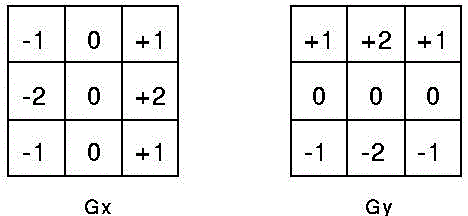 |
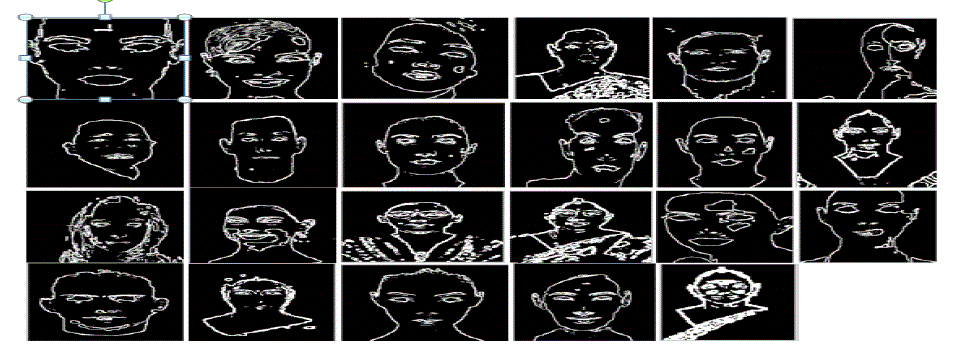 |
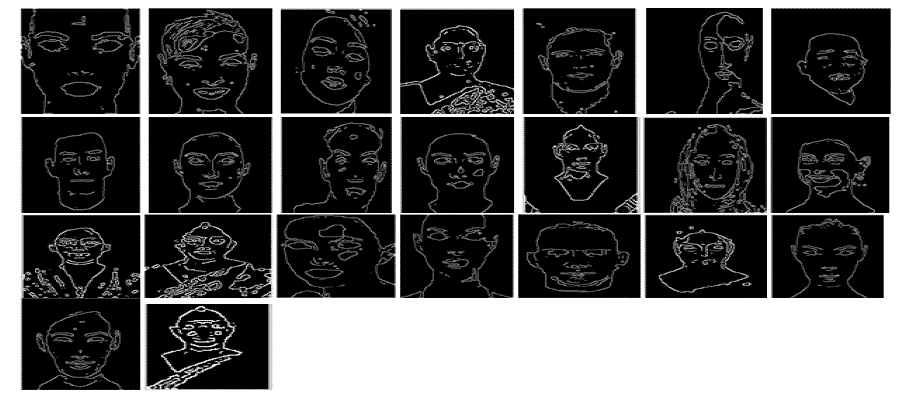 |
| Figure 1 |
Figure 2 |
Figure 3 |
Figure 4 |
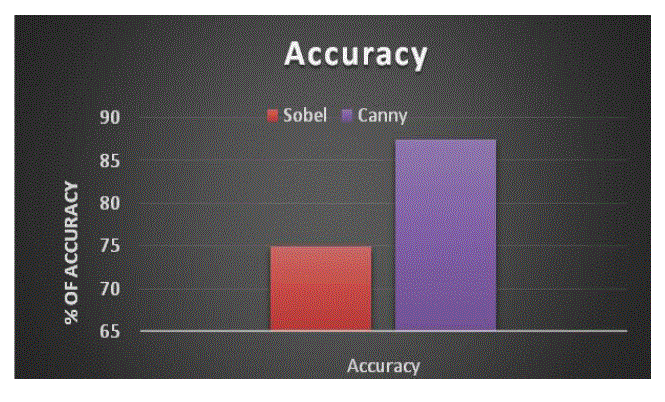 |
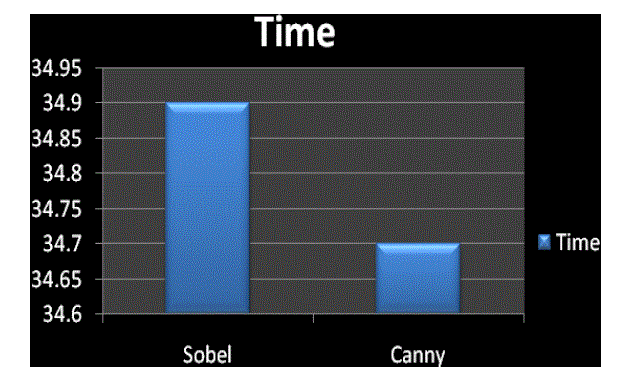 |
| Graph 1 |
Graph 2 |
|
References |
- Zolqemine Othman, habibollahharon, mohammedrafiq, abdulkadir, ―Comparison of canny and Sobel edge detection in mri images‖.
- Mike heath, y sudeepsarkar, thomazsanocki.z and kevinbowyery ―Comparison of edge detectors a methodology and initial‖, Study computer vision and image understanding vol. 69, no. 1, january, pp. 38–54, 1998.
- Mohsen sharifi, mahmoudfathy, maryamtayefehmahmoudi ―A classified and comparative study of edge detection algorithms‖ Proceedings of the international conference on information technology: coding and computing ieee (itccí02) 0-7695-1506-1/02 .
- Mitrabasu, senior member, ieee ―Gaussian-based edge-detection methods—A survey‖, ieee transactions on systems, man, and cybernetics—part c: applications and reviews, vol. 32, no. 3, august 2002.
- M sudarshan*, p ganga mohan and suryakanth v gangashetty ―Optimized edge detection algorithm for face recognition‖.
- G.t. Shrivakshandr.c.Chandrasekar ―A comparison of various edge detection techniques used in image processing‖, ijcsi international journal of computer science issues, vol. 9, issue 5, no 1, september 2012 Issn (online): 1694-0814.
- Pinakipratimacharjya, ritaban das &dibyendughoshal ―Study and comparison of different edge detectors for image segmentation‖, Global Journal of Computer Science and TechnologyGraphics&VisionVolume 12 Issue 13 Version 1.0 Year 2012
- Peter Wilkins, Paul Ferguson, Alan F. Smeaton and CathalGurrin, ―Text Based Approaches for ContentBase Image Retrieval on Large Image Collections‖, Department of Strategic Technology Korea Telecom research Center, Department of Computer Science Korea University, Seoul 137-792, Korea, 1995.
- SoumyaDuttaBidyut B. Chaudhuri International Conference on Advances in Recent Technologies in Communication and Computing 978-0-7695-3845-7/09 $25.00 IEEE 2009.
- Gonzalez G. Hemantha Kumar TianJipeng ―Different Edge Detection Algorithms Comparison and Analysis on Handwritten Chinese Character Recognition‖, International Journal of Computer Applications (0975 – 8887) Volume 47– No.17, June 2012.
- Dr. S.K. Mahendran ―A Comparative Study on Edge Detection Algorithms for Computer Aided Fracture Detection Systems‖, International Journal of Engineering and Innovative Technology (IJEIT) Volume 2, Issue 5, November 2012.
- RajwinderKaur, Monika Verma, Kalpna, Harish Kundra ―Classification Of Various Edge Detectors‖.
- S.Lakshmi, Dr.V.Sankaranarayanan ―A study of Edge Detection Techniques for Segmentation‖ Computing Approaches IJCA Special Issue on―Computer Aided Soft Computing Techniques for Imaging and Biomedical Applications‖ CASCT, 2010.
- VineetSaini, RajnishGarg ― A Comparative Analysis on Edge Detection Techniques Used in Image Processing‖, Journal of Electronics and Communication Engineering (IOSRJECE) PP 56-59,2012.
|